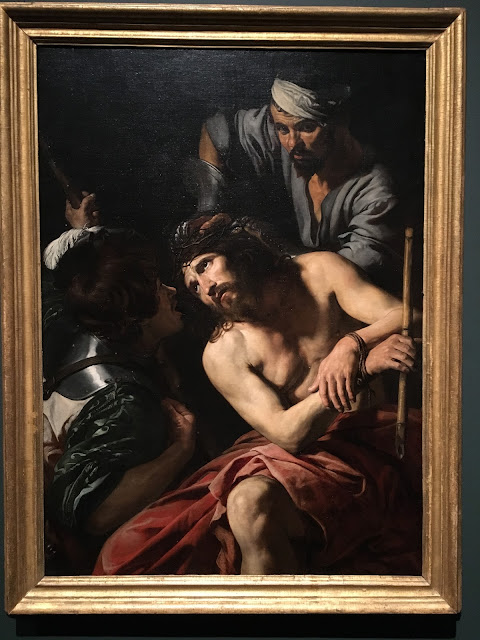 |
| Ecco homo ("Behold the Man") by Valentin de Boulogne (1591-1632) |
Three years ago, Palm Sunday 2020, was the first time that we sent out a livestream video of Mass. “Two weeks to stop the spread” had continued past three weeks and now stretched toward a distant and unknowable vanishing point. We could not simply wait. I asked Thad Ruszkowski for help with the technical side; he and Mike Ward ran cable from the school to connect to the internet, and he and Karl MacMillan assembled all the equipment they were able to beg, borrow, or buy, and launched the transmission. Fr. Russo set up a YouTube channel, and he and Fr. Berhorst concelebrated with me. For reasons I cannot recall we started at 7:30 that morning. Lights, camera, action – right?
If you were watching that morning, you were almost as surprised to hear the Crowd part of the solemn reading of the Passion as Karl and Thad were when they realized that they had to say it. Unlike subsequent Masses, which started at 11:00, and we were joined by Fr. Petty for a few weeks, had John Henderson on the organ and our section leaders singing, and had Daniel, Christina, and Jessica Dao serve, there was no music, no server – it was a grim affair.
We all noticed noise at the doors of the church at some point during the Mass, but not noise like someone was trying to get in. When we unlocked the doors afterward for the faithful to visit the church, we found taped to the door a bulletin on Maryland State Police letterhead.
Groups of more than 10 people in a gathering or at an event are prohibited. This includes social, community, spiritual, religious, recreational, leisure, and sporting gatherings and events.
If the requirements of the Governor’s Executive Order are not complied with, the Maryland State Police and our law enforcement partners will take the appropriate enforcement action, in consultation with the local state attorney’s office. Violation … could result in a misdemeanor conviction and up to one year in jail, or a fine of up to $5,000 or both.
My jaw dropped. My first thought was relief that our doors were obediently locked, and our number inside under ten; then, sympathy for the trooper who, doubtless against his every impulse and training, had to do this most outrageous and unthinkable-in-America thing. I took the notice, and kept it.
It was indeed a hard time. There was real fear, and there was real danger. There was also ignorance, mendacity, and self-interest, and these shaped and motivated many a consequential action. A notice forbidding worship, placed on the doors of a church, by the police? In our home town?
The Church is the Body of Christ on earth. As such, it should surprise us not at all that the Church also suffers. This is not merely the sadness of God that His people are cut off and carried away from Him; it is not merely the lamenting of His ministers that they are prevented from fulfilling their sacred functions. It is also, and perhaps first of all, more than a disservice, but rather an injury to each and all of the people whom Christ has made His own. It is the diminishment of grace and goodness in the lives of all the faithful; a trauma, a debilitating wound that has immediate and lasting effect in their lives and in society. Souls, beautiful immortal souls, fall into desuetude, and death.
This is not China, where recent decrees have made it harder or even impossible for Catholics to worship at all there. This is not Nigeria, where roving bands of jihadist militants burn Catholic churches with the worshippers inside them, fire into crowds outside of churches, and abduct and often murder priests and Christian schoolchildren. This is not Nicaragua, where Communist tyrants imprison and expel the clergy, dismantle the communities, and disperse the people. This is not Egypt, Pakistan, Saudi Arabia, or Bangladesh. And yet: the motivations and manipulations for Catholics to stay away from church are real, insidious, and sometimes even governmental.
It would be naïve and even foolish to continue to assume goodwill or good faith on the part of many of our leaders, official and unofficial, or even all our neighbors. Yet we know that the cross of Christ Jesus is our only hope, and the only path to life and redemption for us and them. We know that Christ humbled himself, becoming obedient to the point of death, even death on a cross. Because of this, God greatly exalted him.
To let drop the Faith because the Church suffers would satisfy and succor only your worst enemy. Come; let us take up our cross and follow Him. Three years have passed, and it is Palm Sunday 2023. Jesus enters Jerusalem, where awaits the Cross.
Monsignor Smith




